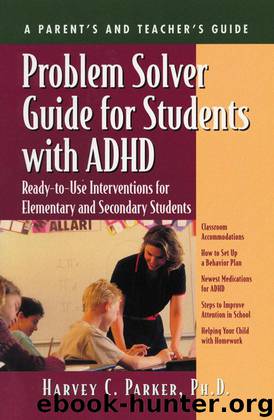Problem Solver Guide for Students With ADHD: Ready-To-Use Interventions for Elementary and Secondary Students by Harvey C. Parker Phd

Author:Harvey C. Parker Phd
Language: eng
Format: mobi
Publisher: Specialty Press/A.D.D. Warehouse
Published: 2001-04-01T21:00:00+00:00
Teaching Study Strategies
•
Encourage students to use visualization to improve recall. By visualizing (forming mental pictures) of facts or concepts we can strengthen our recall. For example, to remember a new vocabulary word try to form a picture in your mind that conveys the meaning.
INCLINATION
Definition:
a liking or leaning toward
(Inclined Nation)
•
Teach students how to form associations between facts or concepts to improve recall. For example, Davis, et al.
(1996) give the example of a student using visualization to help remember that BRUSSELS is the capital of BELGIUM. To do this you can associate the word BRUSSELS to brussel spouts and BELGIUM to Belgium
waffles.
Note: from Leslie Davis, Sandi Sirotowitz, and Harvey C. Parker (1996). Study Strategies Made Easy. Florida: Specialty Press, Inc. Copyright 1996 by Leslie Davis and Sandi Sirotowitz. Reprinted with permission 97
7 Chapter (2005)
97
5/16/06, 10:46 AM
Problem Solver Guide for Students with ADHD
Steps in Writing a Research Paper
1. Select an appropriate topic. Help the student understand that choosing a topic that is too broad or too narrow could make it difficult to write about.
2. Do preliminary research to find out if there is enough information about the topic to fulfill the assignment.
3. Collect sources such as encyclopedias, on-line sources, books, periodicals, etc.
4. Narrow the topic to your specific area of interest.
5. Write a thesis statement—a sentence that states the central theme of the paper.
6. List the main ideas that should be included in the paper and organize the sequence in which they will be included in the paper.
7. List details for each of the main ideas and put in outline form and on note cards.
8. Put the main ideas and details in sentence form in a rough draft.
9. Check spelling, capitalization, and punctuation.
10. Have someone proofread the rough draft.
11. Make certain the rough draft proves the point of the paper and backs it up with facts in a logical order.
12. Rewrite the paper in final form and ask someone to proofread once again.
13. Prepare final copy.
Test-taking Strategies
Students in all grades take tests and could benefit from learning strategies that may improve their test performance.
•
The most common mistake students make when taking tests is they don’t read instructions carefully. Show students how they can benefit by underlining key words in instructions and by taking their time to fully understand what they are supposed to do before they proceed.
98
7 Chapter (2005)
98
5/16/06, 10:46 AM
Teaching Study Strategies
•
Encourage students to take an inventory of the study strategies they use to prepare for tests. Does the student:
✓ start studying well in advance of the test
✓ look over the chapter each night
✓ read the class notes each night
✓ use recall questions to review for a test
✓ have someone quiz them to see how well the information is learned
✓ make notes of the study material that is to be best remembered
✓ read the content over and over
✓ wait until the last minute to study and then cram
✓ get very nervous before a test and can they relax
✓ look over previous tests the teacher has given to get some idea of the
Download
This site does not store any files on its server. We only index and link to content provided by other sites. Please contact the content providers to delete copyright contents if any and email us, we'll remove relevant links or contents immediately.
The Art of Coaching Workbook by Elena Aguilar(50116)
Trainspotting by Irvine Welsh(21031)
Twilight of the Idols With the Antichrist and Ecce Homo by Friedrich Nietzsche(18303)
Fangirl by Rainbow Rowell(8793)
Periodization Training for Sports by Tudor Bompa(7929)
Change Your Questions, Change Your Life by Marilee Adams(7383)
This Is How You Lose Her by Junot Diaz(6445)
Asking the Right Questions: A Guide to Critical Thinking by M. Neil Browne & Stuart M. Keeley(5358)
Grit by Angela Duckworth(5302)
Red Sparrow by Jason Matthews(5199)
Paper Towns by Green John(4804)
Room 212 by Kate Stewart(4741)
Ken Follett - World without end by Ken Follett(4448)
The Sports Rules Book by Human Kinetics(4079)
Housekeeping by Marilynne Robinson(4070)
Double Down (Diary of a Wimpy Kid Book 11) by Jeff Kinney(3932)
Papillon (English) by Henri Charrière(3912)
Exercise Technique Manual for Resistance Training by National Strength & Conditioning Association(3790)
The Motorcycle Diaries by Ernesto Che Guevara(3789)
